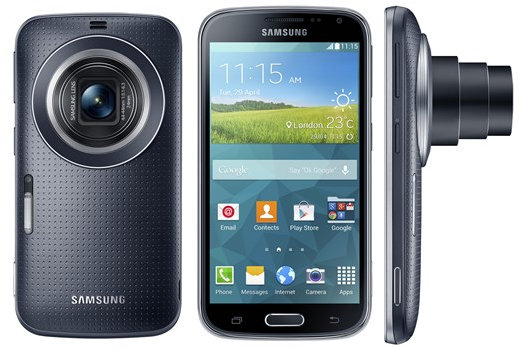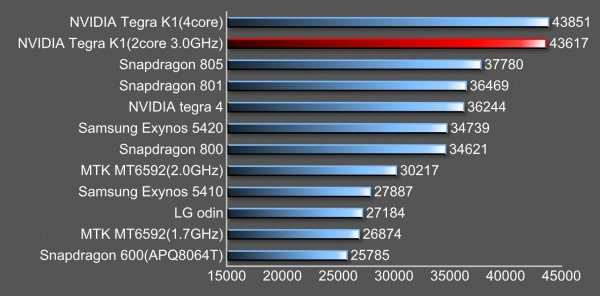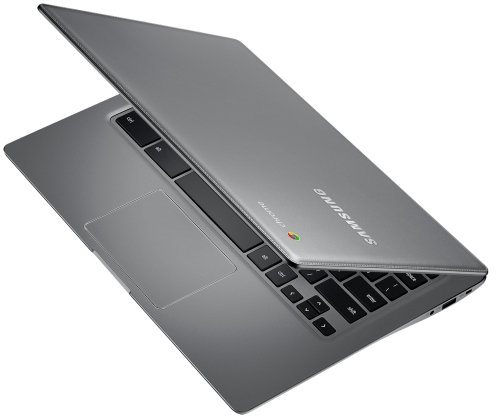Linaro 14.05 has been released with Linux Kernel 3.15-rc5 (baseline), Linux Kernel 3.10.40 (LSK), Android 4.4.2, and Ubuntu has been switched from Saucy to Trusty. More work has been done on big.LITTLE processing and ARMv8 support with notably completing bootstrapping with Debian 64-bit. New hardware platform have started to pop-up such as TI J6-Vayu which must be an evaluation board for Texas Instruments Jacinto 6 dual core Cortex A15 SoC for automotive application, as well as IFC6410, a Snapdragon 600 development board which got a Ubuntu LEB image. This month also marks the first release of Linaro GCC 4.9 toolchain. Here are the highlights of this release: Linux Linaro 3.15-rc5-2014.05 new Android topic (linaro-android-3.15-experimental) uses the resent AOSP code base GATOR version 5.18 (same version as in 2014.04) uprobes topic removed as all patches have been accepted into mainline updated big-LITTLE-pmu topic from ARM LT updated basic Capri board support […]
ARM Cortex A15/A17 SoCs Comparison – Nvidia Tegra K1 vs Samsung Exynos 5422 vs Rockchip RK3288 vs AllWinner A80
We’re now starting to get quite a few players with ARM Cortex A15 cores on the market, as well as some with ARM Cortex A17. So a comparison table of different quad and octa SoCs might be a useful thing to do. I’ve put aside SoCs such as HiSilicon K3V3, and OMAP5, and focused on the four latest processors: Nvidia Tegra K1 (32-bit), Samsung Exynos 5422, Rockchip RK3288 and AllWinner A80. I haven’t included Mediatek MT6595 and Qualcomm SnapDragon 805, because the two companies mainly focus on smartphones and tablets (although it appears to be slowly changing for Qualcomm), documentation is usually difficult or impossible to find, and in the case of Qualcomm they use their own ARMv7 Krait cores. I’ve highlighted some features in green, in case a particular SoC appears to have an edge. Rockchip RK3288 AllWinner A80 Nvidia Tegra K1 Samsung Exynos 5422 CPU 4x ARM Cortex-A17 […]
Samsung Galaxy K Zoom Camera Phone Powered by Exynos 5 Hexa SoC
After Samsung Galaxy S4 Zoom, Samsung has just introduced a new camera-specialized phone called the Galaxy K Zoom with a faster processor, an hexa core processor, which has not been named, but can only be Exynos 5260 hexa core big.LITTLE SoC, a larger 4.8″ display, and a better camera with a 20.7 Megapixel CMOS Sensor and a 10x Optical Zoom. Let’s go straight through the specifications: SoC – Samsung Exynos 5260 Hexa core processor with four Cortex A7 cores @ 1.3GHz, two Cortex A15 cores @ 1.7GHz, and ARM Mali-T624 GPU System Memory – 2GB RAM Storage – 8GB Flash + micro SD slot up to 64GB Display – 4.8″ HD Super AMOLED Display (1280×720) Cellular Network LTE – Cat4, HSPA+ 42Mbps, LTE 800/850/900/1800/2100/2600, HSPA+ 850/900/1900/2100, EDGE/GPRS 850/900/1800/1900 3G – 5-band HSPA+ 42Mbps, HSPA+ 850/900/1900/2100,EDGE/GPRS 850/900/1800/1900 Connectivity – Wi-Fi: 802.11 a/b/g/n 2.4+5GHz, Bluetooth 4.0 BLE, NFC, A-GPS + GLONASS Camera […]
Samsung Gear 2 Smartwatches are Powered by Exynos 3250 SoC
When Samsung announced their Gear 2 and Gear 2 Neo smartwatches running Tizen, they only vaguely mentioned a dual core processor running at 1 GHz powered the devices. SamMobile reports the two watches should be powered by a new processor called Exynos 3250 with two cores and clocked at 1 GHz as initially announced. Ifixit also made a tear down of the Gear 2 watch, and at first, it seems Exynos 3250 is nowhere to be seen, but it turns out it’s probably combined with a DRAM (and Flash?) package named KMF5X0005M, and shown inside a red square in the picture above. Samsung Galaxy Gear, the company’s first smartwatch, was a modified version of Exynos 4212 dual core processor, but using only one core and downclocked to 800 MHz. SamMobile thinks the Gear 2 can use a dual core processor @ 1 GHz, due to battery life gains achieved by […]
Linaro 14.03 Release with Linux Kernel 3.14 and Android 4.4.2
Linaro 14.03 has just been released with Linux Kernel 3.14-rc7 (baseline), Linux Kernel 3.10.33 (LSK), and Android 4.4.2. This month, I could not find any major changes or updates, but work has been performed on big.LITTLE, Samsung Arndale / Arndale-octa, HiSilicon K3V2 and D01 boards and Broadcom Capri hardware, as well as ARMv8 models. Here are the highlights of this release: Linaro Stable Kernel (LSK) 3.10.33-2014.03 big.LITTLE support – ARM MP patch set, IKS (ARMv7 only). Interactive scheduler enhancements ARMv8 features – CPU frequency scaling, CPU topology, CPU suspend Power efficient workqueue support Android v3.10 patch set from AOSP GATOR ARMv8 4xA57 4xA53 FVP (Fixed Virtual Platform) and Versatile Express TC2 support Linux Linaro 3.14-rc7-2014.03 GATOR version 5.17 Android topic (linaro-android-3.14-merge) updated to get the recent code from AOSP uprobes v7 (new version) Updated big-LITTLE-pmu topic from ARM LT (Landing team) Updated basic Capri board support from Broadcom LT (bcm590xx […]
Bluetooth Slide-out Keyboard Cases for Android Smartphones and iPhones
Yesterday, one reader told me he wished manufacturers would release high-end smartphones with a slide-out keyboard, something similar to what Asus has done with Eee Pad Slider SL101 or Archos with their 101 XS Tablet. So I had a look in case some Chinese manufacturers had done a phablet with a slide-out keyboard and Mediatek MT6588 or MT6592 SoC, but all I could find are some old 2011 or 2012 smartphones with Android 2.3 and low specs by today standards. If you own a best selling phone however such as the Galaxy S4, Galaxy S5 or iPhones, there are some cases with a Bluetooth slide-out keyboard that can add this functionality to your phone. The one pictured above is “QQ-Tech Ultra-Slim Slide-Out Detchable Multifunction Wireless Bluetooth Keyboard Case” for Samsung Galaxy S4 which you can find on Amazon for $23. The case comes with a micro USB cable to charge […]
Nvidia Tegra K1 32-bit and 64-bit Benchmarked with Antutu
Nvidia announced their latest Tegra applications processors at CES 2014 with the Tegra K1 32-bit and 64-bit ARM SoCs, as well as Tegra K1 MVC for automotive application. The 32-bit version comes with four Cortex A15 cores up to 2.3 GHz plus a companion core, and the 64-bit version with 2 ARMv8 cores (Cortex A53?) clocked up to 3 GHz. Both SoC features a 192-core Kepler GPU, and we’ve been shown some high-end graphics demo (OpenGL, OpenGL ES, OpenCL…) with in the reference tablet. Some charts has surface showing both 32- and 64-bit Tegra K1 scoring well over 40,000 and with an excellent 3D graphics score. The benchmark was run in reference platform with 32-bit or 64-bit Tegra K1, as well as the Tegra Note P1761 tablet with a 32-bit quad core Tegra K1 processor apparently clocked at a lower frequency, and with a not-that-good flash. The dual core, 64-bit […]
Samsung Chromebook 2 Features Exynos 5 Octa SoC, Comes with either 11.6″ or 13.3″ Display
Samsung has just launched the Chromebook 2 Series with two models based on on Exynos 5 Octa SoC, available in 11.6″ (1366×768) and 13.3″ (1920×1080) configurations, and featuring 4GB RAM, 16GB eMMC, and a longer battery life thanks partially to big.LITTLE processing technology. Samsung expects the new Chromebooks to be used for work, education, and entertainment. Thanks to strong hardware specifications, these new ARM based Chromebooks will certainly offer performance similar to, or even outperforming, existing many Intel Celeron based Chromebooks, and at the same time offer a longer battery life. It’s a nice upgrade to the Exynos 5250 powered Chromebook launched in 2012, especially the addition of a model with a 13.3″ display with FHD resolution. The 13.3″ model has an Exynos 5 Octa processor clocked at 2.1GHz which should be the latest Exynos 5422, whereas the 11.6″ model might use Exynos 5420 instead (TBC). The company also mention […]








